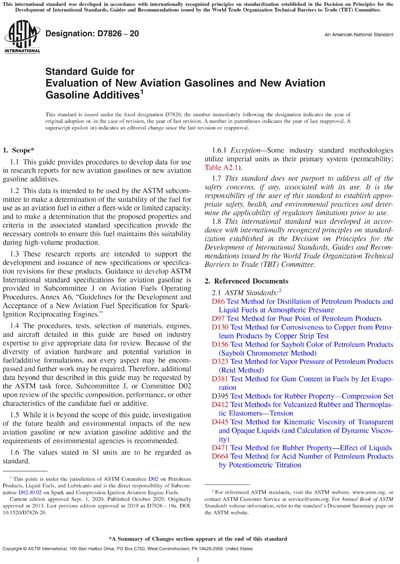Historical
ASTM D7826-20
Standard Guide for Evaluation of New Aviation Gasolines and New Aviation Gasoline Additives
1.1 This guide provides procedures to develop data for use in research reports for new aviation gasolines or new aviation gasoline additives.
1.2 This data is intended to be used by the ASTM subcommittee to make a determination of the suitability of the fuel for use as an aviation fuel in either a fleet-wide or limited capacity, and to make a determination that the proposed properties and criteria in the associated standard specification provide the necessary controls to ensure this fuel maintains this suitability during high-volume production.
1.3 These research reports are intended to support the development and issuance of new specifications or specification revisions for these products. Guidance to develop ASTM International standard specifications for aviation gasoline is provided in Subcommittee J on Aviation Fuels Operating Procedures, Annex A6, “Guidelines for the Development and Acceptance of a New Aviation Fuel Specification for Spark-Ignition Reciprocating Engines.”
1.4 The procedures, tests, selection of materials, engines, and aircraft detailed in this guide are based on industry expertise to give appropriate data for review. Because of the diversity of aviation hardware and potential variation in fuel/additive formulations, not every aspect may be encompassed and further work may be required. Therefore, additional data beyond that described in this guide may be requested by the ASTM task force, Subcommittee J, or Committee D02 upon review of the specific composition, performance, or other characteristics of the candidate fuel or additive.
1.5 While it is beyond the scope of this guide, investigation of the future health and environmental impacts of the new aviation gasoline or new aviation gasoline additive and the requirements of environmental agencies is recommended.
1.6 The values stated in SI units are to be regarded as standard.
1.6.1 Exception—Some industry standard methodologies utilize imperial units as their primary system (permeability; Table A2.1).
1.7 This standard does not purport to address all of the safety concerns, if any, associated with its use. It is the responsibility of the user of this standard to establish appropriate safety, health, and environmental practices and determine the applicability of regulatory limitations prior to use.
1.8 This international standard was developed in accordance with internationally recognized principles on standardization established in the Decision on Principles for the Development of International Standards, Guides and Recommendations issued by the World Trade Organization Technical Barriers to Trade (TBT) Committee.
Content Provider
ASTM International [astm]






